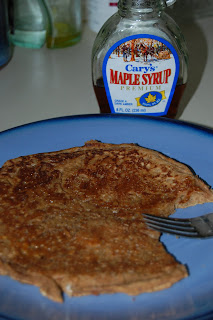I'm sure you've heard many times that "breakfast is the most important meal of the day". Guess what? It is!!! Breakfast is really "breaking the fast". The last meal you had was the night before probably about 10-12 hours prior to waking up.
I loved Dr. Don Colbert's analogy of breakfast and how it affects the rest of your day: "When it comes to breakfast, think of your metabolic rate as a fire in the fireplace. By morning, the fires of metabolism have all but gone out. In order to get the fire going again, you need to eat a healthy breakfast."
So what is a healthy breakfast? One that gives you energy and boosts your metabolism. I'll discuss great breakfast options in a minute, but first let's talk about metabolism.
We hear all the time about thin people having a "fast metabolism", but many don't actually know what metabolism is or does. Metabolism is defined as the chemical processes continuously going on in living cells or organisms that are essential for the maintenance of life. Basically, it is composed of ALL the chemical reactions in the body. The metabolic rate is contributed by all those reactions, such as your heart pumping, lungs breathing, liver doing all 500 functions its meant to do, muscles working...etc.
Since it takes energy for your body's organs to function properly, the metabolic rate is simply the rate you burn calories in a nonactive state (aka: doing nothing...=p). Typically, our bodies burn up to 75% during this nonactive state. So many factors make up the metabolic rate, but one of the biggest factors is: SKIPPING MEALS.
When you have not eaten for more than 12 hours, your metabolic rate goes down by 40%. This is why it is so important to eat breakfast. A good breakfast boosts your metabolic rate and gets your day going strong.
Here are a few breakfast options that are full of fiber, vitamins and minerals to start your day strong:
- Kashi or Cascadian Farms cereals (contain 6-10 grams of fiber per serving)
- Oatmeal with raisins
- Whole wheat toast
- Fruit
- Fresh Orange Juice or Fresh Apple Juice
- Pancakes
- Plain yogurt with fresh fruit and wheat germ
- Almond milk*
For all you coffee lovers, that is not a complete breakfast =). I've heard many of you tell me that eating breakfast makes you nauseous. Start slowly, but for your health, you MUST train yourself to eat a healthy balanced breakfast. Skipping meals, especially breakfast (which is the meal that jump starts your metabolic rate and energy for the rest of the day), will lead to a lower metabolic rate and weight gain.
*I'll be blogging soon on Cow Milk...stay tuned...










